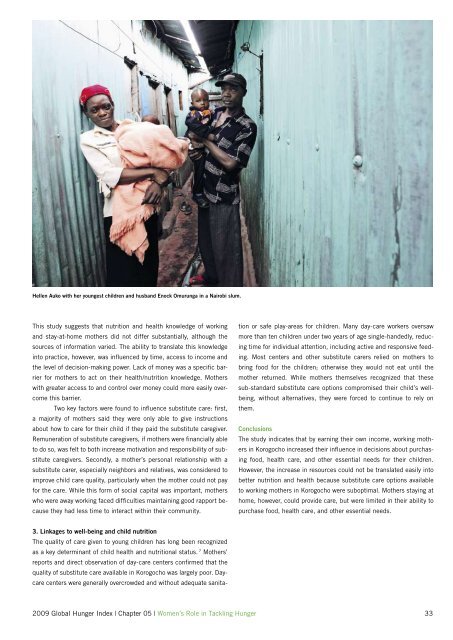2009 Global Hunger Index - International Food Policy Research ...
2009 Global Hunger Index - International Food Policy Research ...
2009 Global Hunger Index - International Food Policy Research ...
You also want an ePaper? Increase the reach of your titles
YUMPU automatically turns print PDFs into web optimized ePapers that Google loves.
Hellen Auko with her youngest children and husband Enock Omurunga in a Nairobi slum.<br />
This study suggests that nutrition and health knowledge of working<br />
and stay-at-home mothers did not differ substantially, although the<br />
sources of information varied. The ability to translate this knowledge<br />
into practice, however, was influenced by time, access to income and<br />
the level of decision-making power. Lack of money was a specific barrier<br />
for mothers to act on their health/nutrition knowledge. Mothers<br />
with greater access to and control over money could more easily overcome<br />
this barrier.<br />
Two key factors were found to influence substitute care: first,<br />
a majority of mothers said they were only able to give instructions<br />
about how to care for their child if they paid the substitute caregiver.<br />
Remuneration of substitute caregivers, if mothers were financially able<br />
to do so, was felt to both increase motivation and responsibility of substitute<br />
caregivers. Secondly, a mother’s personal relationship with a<br />
substitute carer, especially neighbors and relatives, was considered to<br />
improve child care quality, particularly when the mother could not pay<br />
for the care. While this form of social capital was important, mothers<br />
who were away working faced difficulties maintaining good rapport because<br />
they had less time to interact within their community.<br />
3. Linkages to well-being and child nutrition<br />
The quality of care given to young children has long been recognized<br />
as a key determinant of child health and nutritional status. 7 Mothers’<br />
reports and direct observation of day-care centers confirmed that the<br />
quality of substitute care available in Korogocho was largely poor. Daycare<br />
centers were generally overcrowded and without adequate sanita-<br />
tion or safe play-areas for children. Many day-care workers oversaw<br />
more than ten children under two years of age single-handedly, reducing<br />
time for individual attention, including active and responsive feeding.<br />
Most centers and other substitute carers relied on mothers to<br />
bring food for the children; otherwise they would not eat until the<br />
mother returned. While mothers themselves recognized that these<br />
sub-standard substitute care options compromised their child’s wellbeing,<br />
without alternatives, they were forced to continue to rely on<br />
them.<br />
Conclusions<br />
The study indicates that by earning their own income, working mothers<br />
in Korogocho increased their influence in decisions about purchasing<br />
food, health care, and other essential needs for their children.<br />
However, the increase in resources could not be translated easily into<br />
better nutrition and health because substitute care options available<br />
to working mothers in Korogocho were suboptimal. Mothers staying at<br />
home, however, could provide care, but were limited in their ability to<br />
purchase food, health care, and other essential needs.<br />
<strong>2009</strong> <strong>Global</strong> <strong>Hunger</strong> <strong>Index</strong> | Chapter 05 | Women’s Role in Tackling <strong>Hunger</strong> 33

















